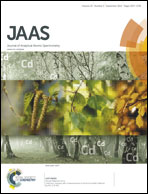Comparison of analytical performance of benchtop and handheld energy dispersive X-ray fluorescence systems for the direct analysis of plant materials
Abstract
The analytical performances of benchtop and handheld energy dispersive X-ray fluorescence spectrometry (EDXRF) systems were evaluated aiming at the direct and simultaneous determination of P, K, Ca, S, Fe, Mn, and Si in plant materials. Pressed pellets of comminuted leaves from 23 varieties of sugar cane were used as laboratory samples. Both systems presented similar figures of merit, and were able to provide useful data for plant nutrition diagnosis. Linear correlation between the elemental mass fractions in the test samples and characteristic X-ray intensities was obtained for all analytes with both types of equipment. Correlation coefficients from 0.9601 to 0.9918 and from 0.9094 to 0.9948 were attained for benchtop and handheld EDXRF, respectively. The coefficient of variation of measurements carried out in 3 different test samples was also appropriate, being lower than 13% for all analytes. Limits of detection were comparable for both systems (20 mg kg−1 for Fe and Mn, and approximately 0.1 g kg−1 for P, K, Ca, S and Si) and permit the evaluation of the mineral nutrition status of sugar cane crop taking into account the critical levels of these elements. The handheld system is a cost-effective and appealing option for those who intend to carry out faster in situ and laboratory analysis with equivalent performance of the benchtop equipment.


 Please wait while we load your content...
Please wait while we load your content...